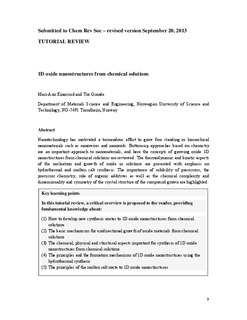| dc.contributor.author | Einarsrud, Mari-Ann | |
| dc.contributor.author | Grande, Tor | |
| dc.date.accessioned | 2014-11-24T13:35:23Z | |
| dc.date.accessioned | 2015-07-02T09:23:27Z | |
| dc.date.available | 2014-11-24T13:35:23Z | |
| dc.date.available | 2015-07-02T09:23:27Z | |
| dc.date.issued | 2014 | |
| dc.identifier.citation | Chemical Society Reviews 2014, 43(7):2187-2199 | nb_NO |
| dc.identifier.issn | 0306-0012 | |
| dc.identifier.uri | http://hdl.handle.net/11250/286364 | |
| dc.description.abstract | Nanotechnology has motivated a tremendous effort to grow free standing or hierarchical
nanomaterials such as nanowires and nanorods. Bottom-up approaches based on chemistry
are an important approach to nanomaterials, and here the concepts of growing oxide 1D
nanostructures from chemical solutions are reviewed. The thermodynamic and kinetic aspects
of the nucleation and growth of oxide in solutions are presented with emphasis on
hydrothermal and molten salt synthesis. The importance of solubility of precursors, the
precursor chemistry, role of organic additives as well as the chemical complexity and
dimensionality and symmetry of the crystal structure of the compound grown are highlighted. | nb_NO |
| dc.language.iso | eng | nb_NO |
| dc.publisher | Royal Society of Chemistry | nb_NO |
| dc.title | 1D oxide nanostructures from chemical solutions | nb_NO |
| dc.type | Journal article | nb_NO |
| dc.type | Peer reviewed | en_GB |
| dc.date.updated | 2014-11-24T13:35:23Z | |
| dc.source.pagenumber | 2187-2199 | nb_NO |
| dc.source.volume | 43 | nb_NO |
| dc.source.journal | Chemical Society Reviews | nb_NO |
| dc.source.issue | 7 | nb_NO |
| dc.identifier.doi | 10.1039/c3cs60219b | |
| dc.identifier.cristin | 1148205 | |
| dc.description.localcode | This journal is © The Royal Society of Chemistry 2014. This is the authors accepted and refereed manuscript to the article. | nb_NO |

